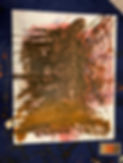WHAT IS ART THERAPY?
Your Intuition, Your Art

What is Art Therapy?
Art therapy is a less verbal form of psychological therapy that uses artmaking techniques to help express and explore emotions. Utilizing art helps us access parts of the brain that traditional talking therapy does not. Many people also find this style of therapy easier or more approachable because it is less verbal. When in an art therapy session, art is made by focusing on the feelings, physical sensations, and materials of the process. There is no end product that you are trying to make. Rather, the journey is the goal. Allowing your intuition to guide you opens doors to accessing your own internal knowledge through creativity.
Art therapy is not the same as arts & crafts or an art class. Trained art therapists are crucial in guiding, containing, and supporting the session and focusing on the process of creating. Art therapy is an accredited form of psychological therapy under HCPC and BAAT governance.

What if I'm not good at art?
Many people may feel afraid or get frustrated in trying to paint or create "something." In art therapy, there is no end goal, giving you the freedom to focus on the creating itself. What colours speak to you? What shapes feel good to make? How does your body move and change when you draw different shapes? Where is your eye led and what does the image want? What do you need in this moment? It is my job as an art therapist to guide you in your making.
Sometimes, in session, no art is made, but rather we imagine colours and speak about shapes and textures. There is no wrong way to show up in art therapy.


How can art therapy help me?
Art therapy gives you permission to express yourself without limits. When we break down boundaries and allow ourselves to explore, we are able to access deep reservoirs of feeling, healing, and wonder. Tap into places words can't reach, feelings that "self-help" articles can't soothe, and peace that social media may be robbing you of. Art therapy can help you explore and process your emotions, and can reveal new strategies and/or coping skills for improving your quality of life. Art therapy may help you with...
-
Neurdivergence and learning differences
-
Life transitions and identity
-
Trauma, PTSD, and self-harm
-
Sexual abuse and domestic violence
-
Citizenship differences or experiences of refugees
-
Addiction
-
Anxiety and intrusive thoughts
-
Bereavement, grief, and loss
-
Relationships and parenting
-
Depression
-
Personality disorders, dissociation, and psychosis
-
Eating patterns and body dysmorphia
-
Chronic pain, physical ailments, and neurological injuries
-
Dementia and Alzheimers
-
Traumatic brain injury
-
LGBTQIA+ experiences
-
Vicarious trauma and service provider reflective practice
-
And more!

Is art therapy for me?
Art therapy is for everyone regardless of age, gender, sexuality, race, or creed. I approach my art therapy practice from a trauma-informed lens, working in a person-centred way that values all of who you are. My art therapy practice is a safe space for everyone. I welcome the
LGBTQIA+ community, refugees and/or those with citizenship differences, people with disabilities, neurodiverse folks, and
all human beings.
If you're curious about exploring your world and accessing healing in a new way, I encourage you to give art therapy a go! You may not think of yourself as an artist or have any previous creative experience - this is absolutely fine. If you're curious about therapy at all, and you've made it this far, something is calling to you. Get in touch with me and let's explore together.


How does art therapy work?
Engaging in the creative changes our neurochemistry. Art therapy engages various brain processes that talking does not, impacting emotional regulation, cognitive flexibility, and stress reduction. It activates emotional centers like the amygdala, promoting better management of emotions. Additionally, creating art fosters neuroplasticity, encouraging the brain to form new connections and pathways. This can enhance problem-solving, relationship, housing, and childcare skills; and improves overall cognitive function and enhances wellbeing.
The multisensory nature of art-making promotes sensory integration, aiding in the processing of sensory information. Art therapy encourages self-expression, enabling individuals to explore and articulate their thoughts and feelings visually. This process of self-reflection can lead to greater self-awareness and personal growth. Art therapy offers a holistic approach to mental health, harnessing the brain's innate capacities for healing and self-discovery.

What happens in an art therapy session?
Before sessions begins, you will have the chance to discuss what has brought you to therapy and what you are hoping to gain from the experience. We will work together to decide on where to go from there. There are lots of opportunities for feedback to make sure you get the most out of yout art therapy experience.
Everyone has different needs, so sessions vary from person to person. I will provide you with a wide range of art materials and encourage you to engage in art-making and exploration. Sometimes this may be connected to a theme or something you have already discussed. Other times, I may offer you a prompt or some direction. Don’t worry about not knowing what to make – I am here to help with that! Together, we will then reflect on the artwork and how you felt while making it.